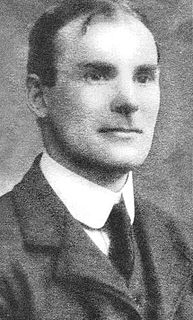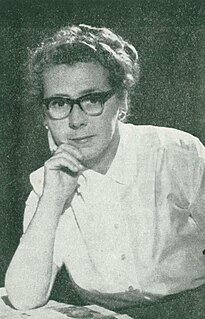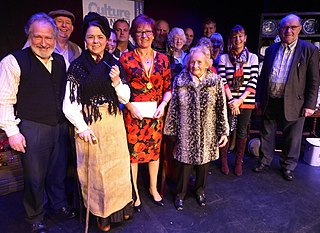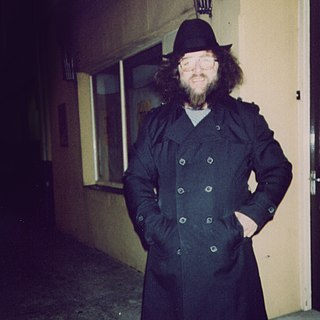Related Research Articles
Yn Chruinnaght is a cultural festival in the Isle of Man which celebrates Manx music, Manx language and culture, and links with other Celtic cultures.

Literature in the Manx language is known from the 16th century. Early works were often religious in theme, including translations of the Book of Common Prayer, the Bible and Milton's Paradise Lost. Edward Faragher, who published poems, stories and translations, is considered the last major native writer of the language. The historian A. W. Moore collected traditional Manx-language songs and ballads in publications towards the end of the 19th century.

Maughold is one of the seventeen parishes of the Isle of Man. It is named for St Maughold, the island's patron saint.
John Joseph Kneen was a Manx linguist and scholar renowned for his seminal works on Manx grammar and on the place names and personal names of the Isle of Man. He is also a significant Manx dialect playwright and translator of Manx poetry. He is commonly best known for his translation of the Manx National Anthem into Manx.

The Master of Man: The Story of a Sin was a best-selling 1921 novel by Hall Caine. The fictional story is set on the Isle of Man and is concerned with Victor Stowell, the Deemster's son, who commits a romantic indiscretion and then gives up on all of his principles in order to keep it a secret. However, in the face of the mounting consequences, Victor confesses publicly to his crime and is punished, but redemption comes through a woman's love. The penultimate of Caine's novels, it is romantic and moralistic, returning to his regular themes of sin, justice and atonement, whilst also addressing "the woman question." It was adapted for a film entitled Name the Man in 1924 by Victor Sjöström.

Mona Douglas was a Manx cultural activist, folklorist, poet, novelist and journalist. She is recognised as the main driving force behind the modern revival of Manx culture and is acknowledged as the most influential Manx poet of the 20th century, but she is best known for her often controversial work to preserve and revive traditional Manx folk music and dance. She was involved in a great number of initiatives to revive interest and activity in Manx culture, including societies, classes, publications and youth groups. The most notable and successful of these was Yn Chruinnaght.

Josephine Kermode (1852–1937) was a Manx poet and playwright better known by the pen name "Cushag".

William Walter Gill (1876–1963) was a Manx scholar, folklorist and poet. He is best remembered for his three volumes of A Manx Scrapbook.
Aeglagh Vannin was a youth group in the Isle of Man whose purpose was the engagement with and revitalisation of Manx language, history and culture. It was established by Mona Douglas in 1931, went through a number of mutations, and faded out in the 1970s. It is best remembered for its central role in the revival of Manx folk dancing.

Kathleen Faragher (1904–1974) was the most significant and prolific Manx dialect writer of the mid twentieth century. She is best known for her poems first published in the Ramsey Courier and collected into five books published between 1955 and 1967. She was also a prolific short story writer and playwright. Her work is renowned for its humour born of a keen observation of Manx characters, and for its evocative portrayal of the Isle of Man and its people.

The Michael Players are the oldest existing body of performers of Manx dialect theatre in the Isle of Man. They are centrally important to the continued tradition of Manx dialect theatre, both through their performances and in their unique collection of Manx plays.

Paul Lebiedzinski was a Manx poet best known for his politically-charged poetry of the 1970s and 80s. He has been described as 'one of the finest poets the Island has produced in modern times.'
Rinkaghyn Vannin is an important book of 28 Manx dances, mostly collected by Mona Douglas, which was published in 1983 by Sleih gyn Thie.
Cyril Clague was the author of the popular Manx dialect poem, The Peel Manx Tay Party.
Edmund Evans Greaves Goodwin was a Manx language scholar, linguist, and teacher. He is best known for his work First Lessons in Manx that he wrote to accompany the classes he taught in Peel.
John William Radcliffe, more commonly known as Bill Radcliffe, or also Illiam y Radlagh, was a Manx language activist, author, and teacher who was involved with the revival of the Manx language on the Isle of Man in the 20th century. His work recording the last native speakers of the language with the Irish Folklore Commission helped to ensure that a spoken record of the Manx language survived.
Leslie Quirk, also known as Y Kione Jiarg was a Manx language activist and teacher who was involved with the language's revival on the Isle of Man in the 20th century. His work recording the last native speakers of the language with the Irish Folklore Commission and the Manx Museum helped to ensure that a spoken record of the Manx language survived.

Shennaghys Jiu(English: Tradition Today) is a four-day youth music and performing arts festival on the Isle of Man. The festival's aim is to give young performers of traditional Manx music and dance the opportunity to come together in a non-competitive environment, and share culture with the other Celtic nations.
Constance Radcliffe was a Manx historian who wrote primarily about the history of the parish of Maughold and the town of Ramsey, both in the north of the Isle of Man. In 1989 Radcliffe was awarded the Reih Bleeaney Vanannan in recognition of her contribution to Manx culture, and was a recipient of the MBE in 1996.

The White Boys is the traditional mummers' play of the Isle of Man.
References
- ↑ "Snippets from the South". Isle of Man Times. 15 January 1960. Retrieved 19 July 2017.
- ↑ The Manx Year Book. Douglas, Isle of Man: Norris Modern Press Ltd. 1924.
- 1 2 3 "Obituary". Ramsey Courier. 4 January 1963.
- ↑ "A Story That's Thrue of a Moddey Dhoo". Ramsey Courier. 20 May 1927. Retrieved 19 July 2017.
- ↑ "Douglas". Isle of Man Examiner. 29 July 1927. Retrieved 19 July 2017.
- ↑ "Peel City Guardian". 19 November 1927. Retrieved 19 July 2017.
- ↑ "Manx Yarns". Mona's Herald. 17 December 1930. Retrieved 19 July 2017.
- 1 2 "Letter from America". Isle of Man Times. January 1960.
- ↑ "Isle of Our Fathers". Ramsey Courier. 24 December 1942. Retrieved 19 July 2017.
- ↑ "Maughold Show, section 06: Betsy Juan-y-Voallyah". Culture Vannin. 2014. Retrieved 19 July 2017.
- ↑ "Mostly T. E. Brown: Manx dialect poems read by Laurence Kermode".
- ↑ "An Evening with the Poets". Ramsey Courier. 12 February 1954. Retrieved 24 July 2017.
- 1 2 "Manx Evening". Ramsey Courier. 28 August 1931. Retrieved 24 July 2017.
- ↑ "Manx Tea and Concert". Peel City Guardian. 10 December 1932. Retrieved 24 July 2017.
- 1 2 "Ramsey Entertainers on the Mainland". Ramsey Courier. 8 January 1937. Retrieved 24 July 2017.
- ↑ "News in Brief". Ramsey Courier. 14 December 1945. Retrieved 24 July 2017.
- ↑ "New one-act play by "Juan Noa"". Ramsey Courier. 4 March 1938. Retrieved 24 July 2017.
- ↑ "London Manx Society". Mona's Herald. 17 December 1946. Retrieved 24 July 2017.
- ↑ "Manx Yarns". Mona’s Herald. 17 December 1930. Retrieved 19 July 2017.
- ↑ "News in Brief". Ramsey Courier. 14 December 1945. Retrieved 19 July 2017.
- ↑ "New Manx Play". Isle of Man Examiner. 11 March 1938. Retrieved 19 July 2017.
- ↑ "London Manx Society". Mona's Herald. 17 December 1946. Retrieved 19 July 2017.